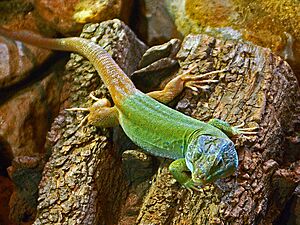Moroccan eyed lizard facts for kids
Quick facts for kids Timon tangitanus |
|
|---|---|
 |
|
| Timon tangitanus at the Prague Zoo | |
| Conservation status | |
| Scientific classification | |
| Genus: |
Timon
|
| Species: |
tangitanus
|
| Synonyms | |
|
|
The Moroccan eyed lizard (scientific name: Timon tangitanus) is a fascinating type of lizard. It belongs to the family called Lacertidae, which includes many different kinds of lizards. This special lizard is found only in Northwest Africa. This means it is endemic to that region.
Contents
Discover the Moroccan Eyed Lizard
The Moroccan eyed lizard is known for its striking appearance. It can grow quite large for a lizard.
What Does It Look Like?
These lizards can reach a total length of about 70 centimeters (27.5 inches). This measurement includes their long tail. Their bodies can be either green or brown. A cool feature is the bright blue spots, called ocelli, found on their backs. These spots look a bit like eyes.
What Do Moroccan Eyed Lizards Eat?
The Moroccan eyed lizard mainly eats small creatures without backbones, like insects. These are called invertebrates. But they also enjoy eating fruits! This makes them omnivores, meaning they eat both plants and animals.
Where Do Moroccan Eyed Lizards Live?
This lizard species lives in specific parts of Northwest Africa.
Geographic Distribution
You can find Timon tangitanus in the mountains of northwestern Algeria. They also live in the Mediterranean areas of Morocco and Western Sahara.
Preferred Habitats
Moroccan eyed lizards like to live in certain types of environments. Their natural habitats include temperate forests. They also enjoy temperate shrublands. You can find them in Mediterranean-type shrubby areas too. They especially like the edges of woodlands, areas with lots of scrub, and rocky places.
Conservation Status: Protecting This Species
Sadly, the Moroccan eyed lizard is facing challenges.
Threats to Their Survival
The biggest threat to Timon tangitanus is habitat loss. This happens when the places where they live are destroyed or changed. This can be due to human activities like building or farming. Protecting their natural homes is very important for their survival.


